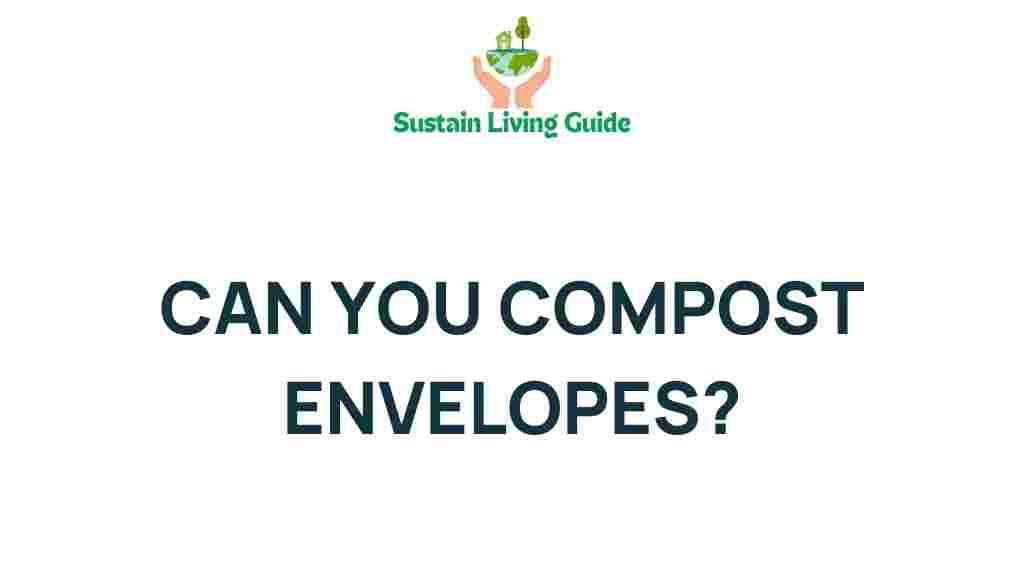Unraveling the Mystery: Can You Compost Envelopes?
Composting has become a popular and eco-friendly way to manage organic waste. Many people are eager to learn about what they can and cannot include in their compost piles. One common question that arises is whether envelopes can be composted. In this article, we will explore the different types of envelopes, their materials, and how they fit into the composting process. Let’s dive into the world of compost!
Understanding Composting Basics
Before we delve into whether envelopes can be composted, it’s essential to understand the basics of composting. Composting is the natural decomposition process that turns organic waste into nutrient-rich soil. It involves a mix of green materials (nitrogen-rich) and brown materials (carbon-rich). Proper composting requires a balance of these materials, along with moisture and air.
What Can You Compost?
Common items you can add to your compost pile include:
- Fruit and vegetable scraps
- Grass clippings
- Leaves
- Coffee grounds and filters
- Eggshells
However, not everything is suitable for composting. It’s crucial to avoid items that can attract pests or introduce pathogens to your compost pile.
Types of Envelopes: A Closer Look
Envelopes come in various types, each made from different materials. Understanding these materials is vital in determining whether they can be composted. Here are the main types of envelopes:
1. Paper Envelopes
Most traditional envelopes are made from paper, which is generally compostable. However, certain factors can affect their compostability:
- Glue: Many paper envelopes use glue that may not break down easily in a compost pile.
- Ink: Some inks can be toxic, so it’s best to use envelopes made from biodegradable inks.
2. Window Envelopes
Window envelopes often have a plastic film that creates a viewing window. This plastic is not compostable and could hinder the composting process. If you use these envelopes, it’s best to remove the plastic before composting the paper part.
3. Plastic Envelopes
Envelopes made from plastic or those that have a plastic coating are not compostable. They can take a long time to degrade and could lead to microplastic pollution in your compost.
Can You Compost Envelopes? A Step-by-Step Process
Now that we’ve identified the different types of envelopes, let’s outline the steps you should take if you decide to compost them:
Step 1: Identify the Envelope Type
Check the envelope for any plastic or non-paper components. If it’s a paper envelope without a plastic window, you can move on to the next step.
Step 2: Remove Non-Compostable Parts
For window envelopes, carefully cut out the plastic window. If the envelope has any plastic coatings or finishes, it’s best to discard it in the trash.
Step 3: Tear or Shred the Envelope
To speed up the composting process, tear or shred the envelope into smaller pieces. This increases the surface area and allows microbes to break it down more efficiently.
Step 4: Add to Compost Pile
Mix the shredded envelope with other compost materials, ensuring a good balance of greens and browns. Aim for a ratio of about 1 part green to 3 parts brown materials.
Step 5: Monitor the Compost
Keep an eye on your compost pile. Turn it regularly to aerate and promote decomposition. Ensure it’s moist but not soggy.
Troubleshooting Tips for Composting Envelopes
Even when you follow the steps above, you might encounter some issues. Here are some troubleshooting tips:
1. Slow Decomposition
If your envelope is taking too long to decompose, it may be due to larger pieces. Ensure you tear or shred the paper into smaller bits. Also, check the moisture level—too dry can slow down the decomposition.
2. Unpleasant Odors
Bad odors can indicate anaerobic conditions in your compost pile. Ensure you’re adding enough browns and aerating the pile regularly.
3. Pests in the Compost
If you notice pests, it might be due to food scraps rather than envelopes. Avoid adding high-sugar foods or meats, which can attract unwanted visitors.
Conclusion
Composting envelopes can be a sustainable option if done correctly. Remember to check the materials, remove any non-compostable elements, and shred the envelopes before adding them to your compost pile. By following these guidelines, you can contribute to a healthier planet while reducing waste.
Are you interested in learning more about composting? Check out our guide on composting basics for more information. And for additional resources on eco-friendly practices, visit EPA’s composting page.
By understanding what you can compost, you can make informed decisions that support both your garden and the environment. Happy composting!
This article is in the category Waste and created by SustainLivingGuide Team
